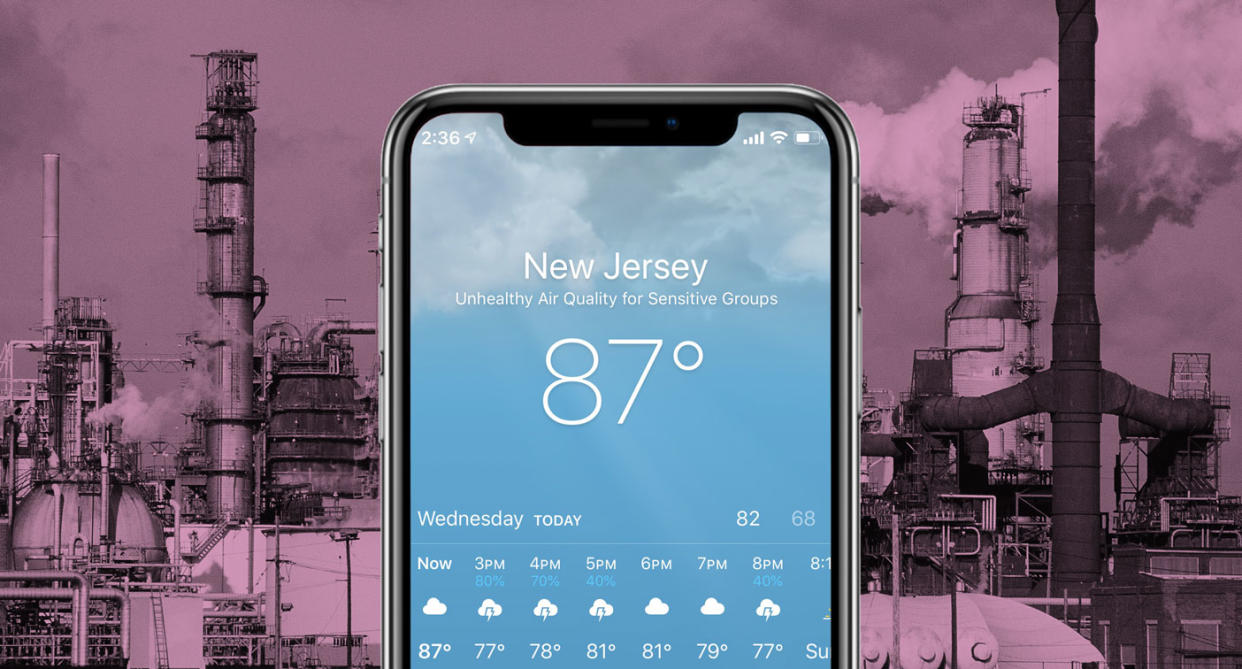Air quality warnings on Apple products: What you need to know

You’re not alone if you’ve noticed air quality warnings in the weather app on your iPhone or Apple Watch. In fact, poor air quality notifications have been issued recently in states such as California, Montana and Oregon due to fires. But it’s not always clear what, exactly, you should do after getting such a warning.
How concerned should you be and what can you do to protect yourself when air quality is particularly poor?
The air quality index in the weather section on Apple products is likely gathered from the Environmental Protection Agency’s Air Quality Index (AQI), which can tell you how clean or polluted the air is in the U.S. (Apple did not immediately respond to Yahoo Lifestyle’s request for comment.) The AQI system looks at five major air pollutants that are regulated by the Clean Air Act — namely, ground-level ozone, carbon monoxide, particle pollution (or particulate matter), sulfur dioxide and nitrogen dioxide — to calculate the air quality, which can range anywhere from zero (healthy air) to 500 (hazardous air).
According to the EPA: “The higher the AQI value, the greater the level of air pollution and the greater the health concern. For example, an AQI value of 50 represents good air quality with little potential to affect public health, while an AQI value over 300 represents hazardous air quality.” (Don’t have an iPhone? You can check your local Air Quality Index here and search by zip code and state.)
Brian Christman, MD, national volunteer medical spokesperson with the American Lung Association, tells Yahoo Lifestyle: “This is really the only way to stay ahead of significant changes in the quality of air in your region. For example, within the last several years, a combination of massive wildfires in British Columbia and unfavorable prevailing winds blew pollutants toward Seattle and Vancouver. On Airnow.gov the quality of the air in Seattle was some of the worst in North America for a few days. I happened to be there and there was obvious irritation of the airways, some burning of the eyes, increased cough and postnasal drip.”
Poor weather quality, like the one Christman describes in Seattle and Vancouver, is particularly problematic for infants, children, the elderly and those with respiratory conditions. “For anyone with asthma or emphysema or congestive heart failure or premature babies, it would have been much worse,” Christman says.
So what should you do if your phone shows there’s a poor air quality warning in effect?
“Having this knowledge can guide people so they know when it would be best to exercise indoors, rather than going for a run, or running their car A/C on the recirculate setting rather than bringing in bad air,” explains Christman. “In extreme situations, it could lead people to using personal protective equipment (PPE), such as N95 masks, to ensure lung safety.”
Even if you’re healthy, the American Lung Association recommends holding off on vigorous outdoor exercise for prolonged periods of time when there’s an air quality warning. “The health effects of pollution are worsened over extended periods of exposure, and by the deep, rapid breathing that accompanies exercise,” the organization explained. “Stay away from high-traffic areas, and do not exercise near those areas.”
More poor air quality warnings may be in our future. Although air quality has gotten better over the last several decades, it appears to be backsliding. In the last two years, the U.S. has experienced more polluted air days than just a few years earlier. According to EPA data analyzed by the Associated Press: “There were 15 percent more days with unhealthy air in America both last year and the year before than there were on average from 2013 through 2016 — the four years when America had its fewest number of those days since at least 1980.”
Read more from Yahoo Lifestyle:
Mosquito-borne virus that causes brain swelling, death in humans detected in Florida
What are brain-eating amoebas — and how can you protect yourself?
People are drinking collagen powder for its anti-aging benefits — but how safe is it?
Follow us on Instagram, Facebook and Twitter for nonstop inspiration delivered fresh to your feed, every day.

